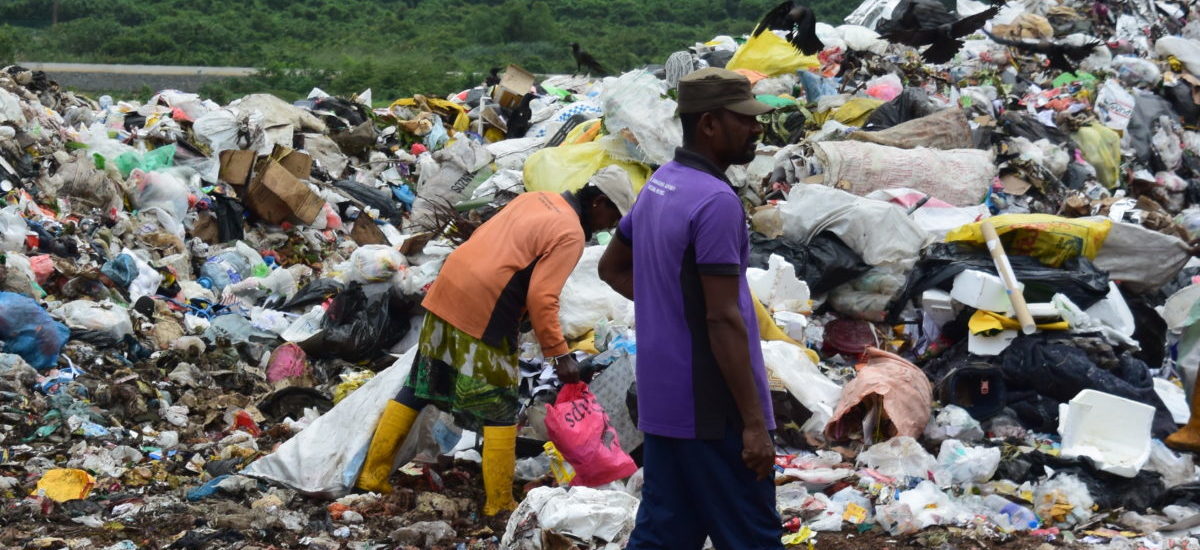Photo courtesy of Blackforest Solutions
The organic fertilizer ship from China was one of the hotly debated topics in Sri Lanka. The quality of the fertilizer shipment, which resulted heated exchanges between the stakeholders, almost sparked a diplomatic brawl between the two countries. During this debacle, the public also reacted with their opinions; some were genuinely concerned about the quality issue while some others were angered by the importation process. Another faction rejected it because it believed that it was a shipment of “fertilizer made out of garbage.” Although the Chinese company is known for making organic fertilizer out of seaweed, I do not know if this particular shipment was made of seaweed, or garbage as some have put it. I want to focus on the sentiment that it was rejected based on the suspicion that it may be made of garbage. My question is what if it was made of garbage? Is it that bad to make organic fertilizer out of garbage?
Making organic fertilizer out of garbage (or waste material) is not a new or a foreign concept. For centuries, cattle manure has been used as fertilizer in Sri Lanka. When chicken farming grew as an industry, chicken manure became popular as another type of organic fertilizer. Backyard composting was not limited to tree leaves; many used kitchen waste too. Animal manure and kitchen waste are essentially garbage too. We should also note that the use of waste material as fertilizer was not something unique to Sri Lanka; this has been the story of the entire humanity. Historically, there was no harm in doing so, as long as the waste material was used safely (especially considering the risk posed by pathogens that may be present in animal manure).
Although it may sound alarming when we look back now, selling night soil (human excreta) as fertilizer was also commonplace not too long ago. This had been the practice in many larger cities around the world until those cities received their sewage collection systems about a century ago. Introduction of city sewage collection systems offered us a way to upgrade the use of human waste in agriculture to a much safer level. When the sewage collected is treated at a wastewater treatment plant, we have the option to use the sewage sludge, one of the safer byproducts of this treatment process, as a soil conditioner in agricultural applications.
Liquid waste (sewage) was not the only type of waste that received a technological upgrade to become useful for agricultural applications; solid waste also followed the same course. When compost making grew as an industry, so did the demand for raw material (feedstock). Where compost making happens in large scale, this increasing demand for feedstock is now met mainly with the solid waste collected by/in cities, which is usually defined as Municipal Solid Waste (MSW). Obviously, the entire volume of MSW cannot be composted. The organic material such as food/yard waste in MSW is the portion that can be used towards compost making. Depending on the lifestyle and the economic status of a population, the percentage of organic waste in their MSW can vary in a wide range. It can be as little as 20% to as high as 70% or more. When you factor in the total volume of MSW, even a low organic fraction such as 20% can still give you a very large volume of organic waste that can provide a guaranteed supply of feedstock for compost making.
The countries that have realized this resourcefulness of organic waste are already benefiting from it: the list includes not only the developed countries but also many developing countries. It is unfortunate to see that Sri Lanka is not among them yet. On the contrary, we are still looking at organic waste with disgust rather than seeing its potential. This unawareness has gone a long way in our society to generate comments like “I do not want any fertilizer made of garbage” that I mentioned earlier. The negative connotation that we have instilled in MSW is mainly due to the unpleasantness of mixed waste. No one sees value in mixed waste. But this perception changes when the same waste is sorted into groups based on different types of material, for example, one pile of paper/cardboard, another pile of glass bottles, another pile of plastics, and perhaps, all organic material such as food waste in another. The minute we separate them, the seemingly useless garbage becomes a bunch of small piles with potentially useful material.
If you want your organic waste to become a useful material like compost, it needs to be separated from other stuff in MSW. Removing larger items such as boxes or bottles or tin cans is doable, although not cost effective to do it manually. But the real challenge is posed by the non-compostable smaller things such as candy wrappers, fractured glass bottles and pieces of styrofoam that may be mixed with the organic material, which you might not even spot easily. Separating organic material from mixed waste is labor intensive and not easy even if you have money or technology. The simple answer is not to mix waste in the first place. The process becomes simpler if you separate them right at the source. This means that the process should begin at home or at your workplace. The compostable material such as food waste you generate in the kitchen (waste produced during/after cooking as well as unwanted/spoiled food) and the garden waste such as leaves and twigs needs to be collected in a separate bin. This method of waste sorting at the point of its generation is called “source separation,” that is in fact regarded as the very first step towards any sustainable solid waste management strategy.
In a way, source separation is also not entirely a new concept. Years ago, our society had a habit of setting aside old newspapers, glass bottles and scrap metals until the next visit of a scavenger who usually shows up once in a few months to collect the materials. What we did back then was exactly source separation. That tradition became almost obsolete when the demand for such secondary use material dropped after markets were flooded with new materials, especially plastics. However, thanks to some recent recycling awareness campaigns, some of us practice source separation again, by setting aside paper/cardboard and plastics. If we want to benefit from organic waste as a society we have to extend the same courtesy, that is, set them aside.
Unlike paper/glass bottles/metals, organic waste is not something that you can set aside and keep for too long. It decomposes rapidly making gas and liquid byproducts that may be unpleasant to bear, attract rodents or insects, and possibly cause health hazards too. What this means is that you have to use it before it is too late. Not everyone is willing or able to make compost in their backyard. Unfortunately, this is where things get complicated. There is little you can do by yourself to contribute to this good cause if your community (neighborhood, village, town, or city) does not have a mechanism to collect your organic waste separately and send it to a composting plant. This is the real issue and this is where we are stuck in the process. We have a very limited number of composting plants, let alone separate collection schemes. We do not have such a system or a culture yet.
What can we do to move forward and benefit from this resource? There are two things that we have to address – awareness raising and capacity development. Thanks to the fertilizer fiasco, composting awareness has gone up in the society. The government has shown clear interest in going for an organic-based agriculture. Although the sudden move caused some unfortunate events and backlash, the same events have increased awareness of organic fertilizer and especially of compost. Within this context, isn’t this the best time to address capacity building as well? I have seen compost making projects failing in other countries mainly due to the lack of demand and inability to compete with government-subsidized chemical fertilizers. However, when there is already more awareness and government backing, I do not see any better time than now for Sri Lanka to capitalize on organic waste composting.
Sri Lanka produces about 7,000 metric tonnes of MSW per day and about 65% of it is organic. In addition to Colombo, which has about a million daytime population, there are 23 other Municipal Councils and 41 Urban Councils covering all provinces that collect (or supposed to collect) MSW every day. The MSW volume from these large population centers will certainly enable the composting industry to have a guaranteed supply of feedstock. The money that we will have to spend on upgrading the MSW sorting and separate collections is in fact a wise investment compared to the benefit this whole process may bring back. When the organic waste, which is 65% of our MSW, is diverted for compost, it already saves money by considerably shrinking the final volume of MSW that needs disposal space. If there is a guaranteed supply of feedstock and a demand for compost, private investors will also jump in to bear the financial burden. Is it not better to invest on this sustainable local solution rather than spending the same money on nurturing a fertilizer importation culture?


